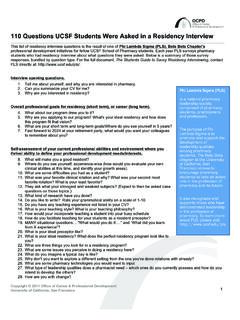Transcription of THE CANADIAN TRIAGE AND ACUITY SCALE
1 THE CANADIAN TRIAGE AND ACUITY SCALE . Combined Adult/Paediatric Educational Program PARTICIPANT'S MANUAL. TRIAGE Training Resources JANUARY 2007. Revised November 2008. Revised April 2012. Version , 2012. Version , November 2013. FOREWARD. Introduction Since five-level TRIAGE was implemented in 1999, the experience gathered both nationally and internationally using CTAS has continued to grow, a body of research has been developed, the CTAS guidelines have been revised, emergency departments have become busier, and the accuracy and reliability of CTAS level assignment is important as CTAS is a good predictor of resource needs.
2 For these reasons, updated training material for new and experienced TRIAGE nurses is required. The goal of CTAS is to support and appropriately assign ACUITY scores that are valid across the broad scope of emergency department presentations ranging from major to minor trauma, cardiovascular complaints, mental health problems, eye pain, obstetrical emergencies, diffuse paediatric presentations and beyond. To achieve this CTAS is structurally simple, content rich and a significant challenge to commit to memory. The design is conducive to computerization and can offer nurses decision support at the point of care.
3 For those sites without programmable emergency department information systems there is a Power point application, Complaint Oriented TRIAGE (COT) which fully integrates the national CEDIS presenting complaint list with the CTAS modifiers and is freely available to download from the CAEP website at This tool can be posted on a computer at TRIAGE for nurses to refer to to assist in their decision making and assigning of a TRIAGE score. Posters and desk reference tools are also available to purchase for education and support at TRIAGE .
4 One final note is that when reporting CTAS data it may be important to define whether or not scores are assigned using computer decision support, computer or paper-based reference materials to support TRIAGE accuracy, or entirely by memory. This information may be important when comparing data from site to site. Copyright 2012 CANADIAN Association of Emergency Physicians (CAEP) with the consent of the CTAS. National Working Group (NWG). This material cannot be copied or used to instruct educational courses without the express permission of CAEP and the CTAS NWG.
5 I Table of Contents Page Forward i Table of Contents ii Acronyms iii Course Overview 1. Course Goals 1. Course Organization 1. Individual Module Objectives 1. Module One: Fundamentals Of TRIAGE 2. The Evolution of TRIAGE 3. What is TRIAGE 3. Avoiding TRIAGE as Access Block 4. TRIAGE Overcrowding 4. Emergency Patients Are Unique 5. The Role Of The TRIAGE Nurse 6. Characteristics Of The TRIAGE Nurse 7. Skills Of The TRIAGE Nurse 9. The Process Of TRIAGE 12. Module Two: Using The CTAS 16. The TRIAGE Process 17. The CTAS Levels 17.
6 Determining The CTAS Level 21. First Order Modifiers 22. Second Order Modifiers 29. Support Quality Standards 32. The TRIAGE Decision 32. Reassessments In Waiting Areas 32. Group Exercise Case Scenarios 32. Module Three: Paying Attention To Special Groups - Paediatrics 34. TRIAGE Guidelines For Paediatrics 35. Comparing Adult And Paediatric TRIAGE 35. CTAS Five Level TRIAGE : Paediatric Examples 35. The TRIAGE Process 36. How Does Paediatric TRIAGE Differ from Adults? 36. Special Paediatric Considerations 36. Psycho-social Differences 37.
7 Critical Look The Paediatric Assessment Triangle 38. Presenting Complaints 40. Subjective Assessment 41. Vital Signs Physiological Assessment 42. Non Physiological Parameters 48. 2nd Order Modifiers 51. Module Four: Special Considerations Second Order Modifiers 54. Introduction 55. Selected Special Complaints 55. Second Order Modifiers 56. Potential TRIAGE Pitfalls 60. CTAS Implementation in Rural Hospitals 60. Appendix A: Acknowledgements Appendix Appendix B: CEDIS Presenting Complaints List Appendix Appendix C: Glasgow Coma SCALE (GCS) Appendix Appendix D: Paediatric Pain Scales Appendix Appendix E: Temperature Measurement Appendix Appendix F: Paediatric Pain Scales Appendix Appendix G: Normal Vitals And Standard Deviations Appendix ii Acronyms The following acronyms are used in this manual.
8 Acronym Meaning ACLS Advanced Cardiac life Support AFA Alternative Funding Arrangements AMUQ l'Association des m decins d'urgence du Qu bec BP Blood Pressure CAEP CANADIAN Association of Emergency Physicians CEDIS CANADIAN Emergency Department Information System CIAMPEDS Complaint, Immunisation/Isolation, Allergies, Parents Perception/Past History, Events, Diet/Diapers, Symptoms CIHI CANADIAN Institute of Health Informatics COPD Chronic Obstructive Pulmonary Disease CPS CANADIAN Paediatric Society CTAS CANADIAN TRIAGE and ACUITY SCALE CTAS 1 Resuscitation CTAS 2 Emergent CTAS 3 Urgent CTAS 4 Less Urgent CTAS 5 Non Urgent ED Emergency Department EMS Emergency Medical Service ENAO Emergency Nurses Association of Ontario ENPC Emergency Nursing Paediatric Course ENT Ear, Nose.
9 Throat FEV Forced Expiratory Volume in 1s FRI Febrile Respiratory Illness GCS Glasgow Coma SCALE ICD 10 International Classification of Diseases ILI Influenza Like Illness MCC Motor Cycle Collision MOI Mechanism of Injury MOHLTC Ministry of Health and Long Term Care MVC Motor Vehicle Collision NACRS National Ambulatory Care Reporting System NENA National Emergency Nurses Affiliation, Inc. NWG CTAS National Working Group OB/GYN Obstetricts/Gynaecology OHA Ontario Hospital Association O2 Sat Oxygen Saturation PALS Paediatric Advanced Life Support PEFR Peak Expiratory Flow Rate RN Registered Nurse RR Respiratory Rate SRPC Society of Rural Physicians of Canada TNCC Trauma Nursing Core Course iii COURSE OVERVIEW.
10 Course Goals At the end of this course you will be able to: 1) Describe the historical origins and role of TRIAGE . 2) Review and enhance your patient assessment skills. 3) Apply professional standards of emergency nursing practice to TRIAGE . 4) Introduce and utilize the CEDIS Presenting Complaint List. 5) Prioritize patient care based on the CANADIAN TRIAGE ACUITY SCALE (CTAS). 6) Demonstrate an understanding of patient flow, care processes and communication in the Emergency Department (ED). Course Organization The course is divided into four separate modules dealing with various TRIAGE subjects: Module 1: Fundamentals of TRIAGE Module 2: Using the CTAS.

